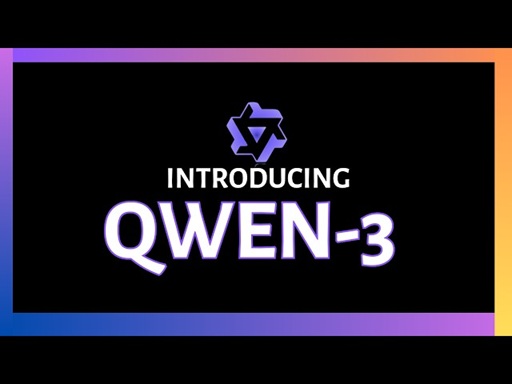
Introduction
This overview introduces the new Qwen-3 model family, a highly anticipated release alongside DeepSeek R2. The models demonstrate exceptional performance relative to their size, with a distinctive hybrid architecture that enables reasoning capabilities to be toggled on or off as needed. Qwen-3 particularly excels at coding and agentic tasks, and includes support for Multi-Agent Conversational Programming (MCPs). This summary outlines the key findings from an initial review of the Qwen-3 models.
Qwen-3 Model Overview
Qwen-3 is a major new language model release from Alibaba Cloud that represents a significant advancement in open-weight AI models. Here is a comprehensive overview of the Qwen-3 model family:
Model Lineup
Qwen-3 consists of eight different models:
- Six dense models of varying sizes
- Two Mixture-of-Experts (MoE) models
Size ranges from the smallest 6B parameter model to the largest 235B MoE model (with 22B active parameters).
Key Innovations
Hybrid Thinking Architecture
The most distinctive feature of Qwen-3 is its hybrid thinking capability, allowing users to toggle between:
- Thinking mode: Produces step-by-step reasoning for complex tasks
- Non-thinking mode: Provides rapid responses for simpler questions
This is controlled via a single hyperparameter, making it the first open-weight model family to offer this capability.
Performance
- The 235B MoE model outperforms OpenAI’s o1 and competes with Gemini 2.5 Pro on several benchmarks
- The 32B dense model compares favorably with OpenAI’s o1 and exceeds DeepSeek R1
- Even smaller MoE models (with just 3B active parameters) outperform previous 32B Qwen models
Technical Specifications
- Context window: 32K tokens for smaller models, up to 128K for larger models
- Architecture: Similar to DeepSeek v2
- Multimodal capabilities: Supports image understanding
- Language support: 119 languages including African languages, Turkish, Arabic, and others
- License: Released under Apache 2.0
Training Process
Pre-training
- Trained on approximately 36 trillion tokens (double the data of Qwen-2.5)
- Utilized high-quality synthetic data generated by Qwen-2.5 models
- Three distinct pre-training stages:
- Initial training on 30+ trillion tokens with 4K context
- Additional 5 trillion tokens focused on knowledge-intensive content
- Extension to 32K context window with high-quality long-form content
Post-training
Four-stage process that enables the hybrid thinking capabilities:
- Fine-tuning with chain-of-thought data across various domains
- Reinforcement learning with rule-based rewards
- Integration of non-thinking capabilities alongside thinking mode
- General reinforcement learning across 20+ domains for alignment
Advanced Capabilities
Tool Integration
- Native support for Multi-Agent Conversational Programming (MCPs)
- Can use tools sequentially within its reasoning chain
- Capable of advanced agentic behaviors similar to closed models
Coding Performance
- Particularly strong at coding tasks
- In some benchmarks, even smaller Qwen-3 models outperform GPT-4o on coding capabilities
Deployment Options
- Model weights: Available on Hugging Face
- Chat interface: Accessible at chat.qwen.ai
- Recommended deployment tools: VLM or SG lang for production (not Ollama/LM Studio)
- Integrates with numerous existing AI frameworks and tools
Usage Example
In the Transformers library, enabling or disabling thinking is as simple as setting a flag:
# Enable thinking
tokenizer = AutoTokenizer.from_pretrained("Qwen/Qwen3-7B", enable_thinking=True)
# Disable thinking
tokenizer = AutoTokenizer.from_pretrained("Qwen/Qwen3-7B", enable_thinking=False)
The Qwen-3 family represents a significant step forward in open-weight language models, offering capabilities previously only seen in closed frontier models while maintaining an open license and flexible deployment options.
Video about Qwan-3:
Key Points from Video
Model Lineup and Benchmarks
- Eight models were released: two mixture-of-experts (MoE) and six dense models
- Size range: from 6 billion to 235 billion parameters
- The 235B MoE model (with 22B active parameters) outperforms OpenAI’s o1 and compares favorably with Gemini 2.5 Pro
- The 32B dense model is comparable to OpenAI’s o1 and beats DeepSeek R1
- Smaller MoE models with just 3B active parameters outperform previous 32B Qwen models (10x larger)
- Models released under Apache 2.0 license with weights available on Hugging Face
Technical Specifications
- Context windows: 32K tokens for smaller models, up to 128K tokens for larger models
- Architecture appears similar to DeepSeek v2
- Models were pre-trained at 32K tokens then extended to 128K through post-training
- Recommended deployment tools for production: VLM or SG lang (not Ollama/LM Studio)
- Multimodal capabilities with support for 119 languages including African, Turkish, and Arabic
Hybrid Thinking Architecture
- First open-weight models with on-demand thinking capabilities
- Thinking mode: step-by-step reasoning for complex tasks (slower but more accurate)
- Non-thinking mode: quick responses for simpler questions
- Controllable via a single hyperparameter in the same model
- Performance dramatically improves with thinking enabled (up to 100% on some benchmarks)
Training Process
- Pre-trained on 36 trillion tokens (2x more than Qwen-2.5)
- Used high-quality synthetic data generated by Qwen-2.5 models
- Three-stage pre-training:
- 30+ trillion tokens with 4K context window
- 5 trillion additional tokens with increased STEM/coding/reasoning content
- High-quality long context data to extend to 32K tokens
- Four-stage post-training:
- Fine-tuning with chain-of-thought data for reasoning
- RL with rule-based rewards for exploration/exploitation
- Integration of non-thinking capabilities
- General RL across 20+ domains for alignment
Tool Integration and MCPs
- Native support for Multi-Agent Conversational Programming (MCPs)
- Capable of using tools sequentially within chain-of-thought reasoning
- Similar tool-use patterns to what’s seen in closed models like o3
- Simple API for enabling/disabling thinking via a flag parameter
Conclusion
The release of Qwen-3 represents a significant advancement in open-weight language models, setting a high bar for upcoming competitors like DeepSeek and potentially new Llama models.
5 Key Takeaways:
- Qwen-3 delivers frontier-model performance in significantly smaller packages, with MoE models offering exceptional efficiency (22B active parameters competing with much larger models).
- The innovative hybrid thinking architecture allows users to toggle between fast responses and deep reasoning within the same model.
- The four-stage post-training process enabled both the thinking/non-thinking capabilities and extended context windows.
- Strong tool-use and agentic capabilities, including MCPs support, make these models particularly valuable for coding and complex reasoning tasks.
- The heavy use of synthetic data generated by previous Qwen models demonstrates how AI systems can effectively bootstrap their own improvement.


